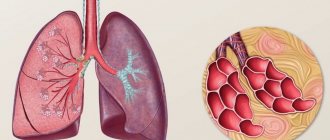Let's figure out what really helps and whether you need to take antibiotics right away for Covid-19
It is believed that the main threat from coronavirus is lung damage. How does covid infection occur, and at what point does the process become complicated by bacterial pneumonia? How to distinguish one from the other, is there a way to protect yourself in advance and prevent COVID-19 from turning into pneumonia, Vladimir Beketov, candidate of medical sciences, pulmonologist at Sechenov University, told kp.ru.
The first thing that is important to understand, the expert says, is that the new coronavirus infection is a viral infection and is included in the group of acute respiratory viral infections. The only thing that stands apart from this group is influenza. This means that COVID-19, like all respiratory viral infections that affect the upper respiratory tract and lungs, is characterized by the following phenomenon. Immune defenses in the lungs weaken. Therefore, it becomes possible for a secondary bacterial super-infection to occur approximately on the 5th – 9th day of the course of any acute respiratory viral disease.
“Since Covid is a special disease, and it does not progress as quickly as the flu, for example, the addition of a bacterial infection, as a rule, occurs with COVID-19 towards the end of the second week,” says pulmonologist Vladimir Beketov.
What is pneumonia
— This is a disease of the lower respiratory tract, in particular the alveoli.
This is where gas exchange occurs during breathing. Depending on the causative agent, pneumonia is divided into bacterial and viral. Initially, we only talked about bacterial pneumonia for many years. Viral ones were rare. Everything changed after 2009, when the so-called swine flu pandemic occurred. Viral pneumonia has become a fairly common complication of the disease.
Bacterial pneumonia can also be a complication of influenza or other viral illness. Viral disease is characterized by a rapid onset and a sharp onset of respiratory failure. The prognosis is poor because large areas of the lungs are affected at once.
If we are talking about viral pneumonia associated with COVID-19, then its course resembles that of swine flu.
Viral pneumonia is a manifestation of the severe course of coronavirus infection COVID-19. Sometimes microbial flora is also added, then we talk about a bacterial-viral infection.
In the Altai Territory, the number of pneumonias has always been higher than in the European part of Russia and even compared to its neighbors in the Siberian District. It is impossible to explain this by climate or standard of living.
Regional clinical hospital for emergency medical care.
Anna Zaikova.
What are the symptoms of viral pneumonia in adults and adolescents?
The symptoms of the disease at the beginning cannot be distinguished from acute respiratory diseases. At the first stage, viral pneumonia is accompanied by:
- high temperature;
- chills;
- aches in joints and muscles;
- sore throat;
- dry cough;
- shortness of breath and wheezing;
- general weakness;
- sharp pain behind the sternum.
At the second stage of the disease, a dry cough gives way to a wet cough with yellowish to rust-colored sputum. The temperature continues to remain high for 10-15 days.
Symptoms in adolescents do not differ from the manifestations of the disease in adult patients. Among schoolchildren and older youth, viral pneumonia is extremely rare.
Can pneumonia occur separately from ARVI and influenza?
- Maybe. This is an infectious disease that is transmitted from person to person. Everyone in the body has a complex and multi-stage defense mechanism that does not allow viruses and bacteria to penetrate into the deep respiratory tract: microbes settle during aerodynamic filtration, on the mucous membranes, in the larynx, in the branches of the bronchi - so to speak, “at the bends”.
The bronchi also contain ciliated epithelium, which is in constant motion towards exit into the oral cavity. Mucus is secreted there, which carries the germs back. Plus the immune system works.
Pneumonia is not only a complication of viral diseases. It was during its study that, for example, they discovered legionella, which loves to live in air conditioners. In 1976, more than 200 military veterans attending an American Legion convention in Philadelphia fell ill. Several dozen later died from this previously unknown disease. There was just air conditioning there.
The massiveness of the dose and high virulence - infectiousness, in other words, played a role. This is exactly what we are seeing now with coronavirus. It itself is highly contagious and active, so the body, especially if it is weakened, cannot protect itself from it. Although it is known that about 20% of those infected are asymptomatic.
District hospital.
Dmitry Lyamzin.
Is there a vaccine against this disease?
{banner_banstat7}
The vaccine against pneumonia is widely known and is one of the mandatory vaccinations for children, but it involves protecting the body from pneumococci. Accordingly, this vaccination protects against the bacterial form of the disease. And this vaccine alone is not enough to protect against viral pneumonia. There is no vaccine against this disease, as such. But there are vaccines against various viruses.
Since the same viruses can cause both influenza and pneumonia, the influenza vaccine can also be considered a vaccine against viral pneumonia.
It is known that influenza viruses are constantly modified, so vaccines are also regularly improved. Every year, drugs are created against the most common strains of the virus at the moment. In this regard, it is necessary to be vaccinated annually in the fall, no later than two weeks before the expected development of the seasonal epidemic. After using the vaccine, antibodies are produced in the body within two weeks.
Even if a vaccinated person is still infected, the disease will pass in a very mild form. It is impossible to become infected from vaccination, since the vaccine does not contain live bacteria or viruses.
What is the difference between community-acquired and hospital-acquired pneumonia?
— Hospital-acquired pneumonia occurs in people who are hospitalized with any disease. That is, a person is initially more weakened. Such pneumonia requires different treatment.
Nosocomial pathogens of pneumonia are found in every intensive care unit, in every intensive care unit, or simply in a department. They are quite difficult to fight. Maternity hospitals have the practice of completely closing for a month to completely “wash themselves out.” In theory, this should be done in all hospitals, but it is impossible to close, for example, the intensive care unit of a regional clinical hospital.
In community-acquired pneumonia, the causative agent is more clear and defined. The flu season is coming, and we know what type it will be, so we can immunize the population in advance. Microbes that cause community-acquired pneumonia have long been known and described. In 80% of cases it is pneumococcus. In adults they cause pneumonia, in children - meningitis, otitis, and sinusitis. The next most common are intracellular pathogens: Klebsiella, Mycoplasma, Legionella.
In this regard, it is easier to decide on initial therapy. Most often, treatment begins with an antibiotic that acts on pneumococcus; if after three days it does not help, we prescribe drugs against intracellular pathogens.
Community-acquired pneumonia may be milder than hospital-acquired pneumonia. There are even at-home treatment options.
Medicine. Hospital.
unsplash.com
Diagnostics
Among atypical pneumonias in adults, mycoplasma pneumonia occurs, which is most often diagnosed not immediately, but after some time. In the first days of development, atypical pneumonia is mistakenly diagnosed as bronchitis or acute respiratory infections. In the case of mycoplasma or chlamydial pneumonia, X-ray examination is not informative. This type of pneumonia is determined using a serological test or using PCR (polymerase chain reaction).
These types of microorganisms are difficult to determine using culture diagnostics - they belong to intracellular pathogens. The patient often has a dry cough with no sputum. Isolation of microorganisms from clinical material requires energy-rich media, and culturing bacteria requires a long incubation period—sometimes up to two weeks. Due to the ability of mycoplasma to survive for a long time in the human body, the isolation of bacteria does not confirm the acute phase of mycoplasma infection.
Mycoplasma infection in most cases ends in recovery, which cannot be said about mixed types of infections, which are very difficult. Most often, mycoplasma infection affects people in childhood and young age, less often before the age of 40, and very rarely after the age of 60. Most often, adults are diagnosed with pneumonia caused by streptococcus and chlamydia.
At the Yusupov Hospital, the patient undergoes a quick and effective diagnosis of the disease. The doctor of the therapeutic department conducts an examination and, if necessary, refers you to specialists for consultation to rule out pulmonary tuberculosis. The patient is prescribed the most effective antibacterial therapy for this case of pneumonia. Treatment of pneumonia should be carried out in a hospital setting under the supervision of a physician. You can make an appointment with a hospital specialist by calling the clinic.
How to treat pneumonia
— This is primarily antimicrobial therapy. Plus symptomatic treatment - mucolytics, bronchodilators. This is individual for each patient. General: antibiotics.
However, you need to understand that antibiotics do not work on the virus. That’s why we always say that if you have ARVI or influenza, you can’t “prescribe” these drugs to yourself. This way you will only weaken the immune system, and if the microbial component also joins, then the body’s reserves will be exhausted, and this can lead to more serious complications.
For pneumonia during swine flu, there were several antiviral drugs with proven effectiveness. Now, with coronavirus infection, it is quite difficult to decide on therapy, since experience in using certain medications is only being gained.
It’s good that the epidemic did not start here, we have the opportunity to use the developments of our Moscow colleagues, they regularly review methods. On October 1, we already had the eighth version of the methodological recommendations.
Doctors, hospital
unsplash
Prevention
To protect yourself from pneumonia, you need to regularly follow simple rules that will also help you avoid other diseases:
- observe the rules of personal hygiene: wash your hands after going outside and using public transport, use hand sanitizers;
- eliminate bad habits. Smoking, alcohol abuse, and drug use have a detrimental effect on the condition of the entire body, in particular on the respiratory system;
- if you have chronic diseases, regularly visit your doctor to monitor the condition, since the constant presence of pathology negatively affects the immune system;
- lead a healthy lifestyle. Exercising, a healthy diet, and normal sleep help normalize the functioning of all organs and systems and strengthen the body's defense mechanisms.
When the first signs of the disease appear, you should immediately consult a doctor. At the Yusupov Hospital, patients are provided with all the necessary assistance to eliminate their illness. Effective treatment methods promote a speedy recovery and minimize the risk of developing negative consequences.
After suffering from pneumonia, the Yusupov Hospital offers to undergo a rehabilitation course, which allows you to normalize the body’s functioning much faster and restore its functions. You can make an appointment with a therapist, pulmonologist or rehabilitation specialist, or get advice from other specialists by phone.
Make an appointment
How is pneumonia diagnosed?
- A CT scan will show changes in the airways. Based on the severity of these changes, the detected pneumonia is divided into four types, from the mildest (CT-1) to the most severe (CT-4).
But in fact, computed tomography is far from the first place in clinical recommendations. Pneumonia has always been diagnosed using radiography and even fluorography, which will also show lesions in the lungs.
Medicine. Hospital.
unsplash.com
What are the dangers of pneumonia?
- Respiratory failure and generalization of the process - that is, sepsis. In addition to the lungs themselves, the heart, kidneys, and brain are also affected. There may be extensive pulmonary edema, infectious-toxic shock, multiple organ failure. This can ultimately be fatal.
If a person has suffered a mild form of pneumonia, then it is recommended to avoid hypothermia for a month. In the case of covid pneumonia with a large volume of lung damage, there is a high probability that respiratory failure will remain for a long time, maybe even forever.
This is due to the fact that so-called pneumosclerosis occurs when the lung tissue is replaced by connective tissue that is not capable of breathing. Such people complain of constant shortness of breath and the inability to endure intense physical activity.
People need long-term rehabilitation, including physical therapy. A diet high in proteins, vitamins, and fiber is required.
Sometimes the help of a psychotherapist is required, as we observe cognitive impairment due to hypoxia. Plus, many survivors of severe forms of COVID-19 may have a persistent fear of death.
Treatment
{banner_banstat4}
How to treat viral pneumonia is decided by the doctor after diagnosis. First of all, the patient is prescribed bed rest and plenty of fluids - up to 3 liters of fluid per day.
. Patients of younger preschool and older age are subject to hospitalization, the rest are usually treated at home.
Therapy is carried out in two directions:
- etiological;
- symptomatic.
Etiological treatment is the fight against the cause of the disease, that is, a specific virus. The choice of drug depends on its type.
- For pneumonia caused by the influenza virus, the drugs Remantadine, Tamiflu or Relenza should be used.
- Measles and chickenpox viruses are treated with Acyclovir or Isoprinosine.
- Cytomegalovirus can be treated with Ganciclovir.
- For respiratory syncytial pneumonia, Ribavirin is prescribed.
- If there is a suspicion of a bacterial infection, the doctor prescribes macrolide antibiotics (Rovamycin, Rulid) or benzylpenicillin (Ampicillin, Flemoxin, Amoxiclav)
Symptomatic treatment depends on the severity of the various manifestations of the disease.
- Fever, aches in the joints and muscles are well relieved by antipyretic and painkillers Ibuprofen, Paracetamol in tablets or syrups for children, as well as complex drugs - Pentalgin, Fervex, Theraflu in tablets or powders.
- Expectorants Ambroxol, Acetylcholine, herbal preparations Gerbion, Linkas, Doctor Mom in the form of tablets, syrups, and solutions for inhalation will help relieve coughs and facilitate the discharge of sputum.
- For shortness of breath, oxygen therapy is prescribed - treatment with oxygen.
- In case of vascular insufficiency, a solution of cordiamine or caffeine is administered intramuscularly.
- Vitamins are prescribed both for prevention and during treatment.
- During the recovery period, the patient is required to undergo physiotherapeutic treatment.









